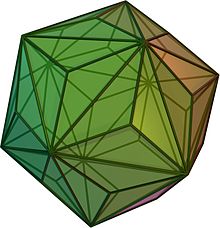| Triakis icosahedron | |
|---|---|
 | |
| Type | Catalan solid Kleetope |
| Faces | 60 isosceles triangles |
| Edges | 90 |
| Vertices | 32 |
| Symmetry group | Icosahedral symmetry |
| Dihedral angle (degrees) | 160°36'45.188" |
| Dual polyhedron | truncated dodecahedron |
| Properties | convex face-transitive |
| Net | |
 | |
In geometry, the triakis icosahedron is an Archimedean dual solid, or a Catalan solid, with 60 isosceles triangle faces. Its dual is the truncated dodecahedron. It has also been called the kisicosahedron.[1] It was first depicted, in a non-convex form with equilateral triangle faces, by Leonardo da Vinci in Luca Pacioli's Divina proportione, where it was named the icosahedron elevatum.[2] The capsid of the Hepatitis A virus has the shape of a triakis icosahedron.[3]
- ^ Conway, John H.; Burgiel, Heidi; Goodman-Strauss, Chaim (2008). The Symmetries of Things. AK Peters. p. 284. ISBN 978-1-56881-220-5.
- ^ Brigaglia, Aldo; Palladino, Nicla; Vaccaro, Maria Alessandra (2018). "Historical notes on star geometry in mathematics, art and nature". In Emmer, Michele; Abate, Marco (eds.). Imagine Math 6: Between Culture and Mathematics. Springer International Publishing. pp. 197–211. doi:10.1007/978-3-319-93949-0_17. ISBN 978-3-319-93948-3.
- ^ Zhu, Ling; Zhang, Xiaoxue (October 2014). "Hepatitis A virus exhibits a structure unique among picornaviruses". Protein & Cell. 6 (2): 79–80. doi:10.1007/s13238-014-0103-7. PMC 4312766. PMID 25359464.
